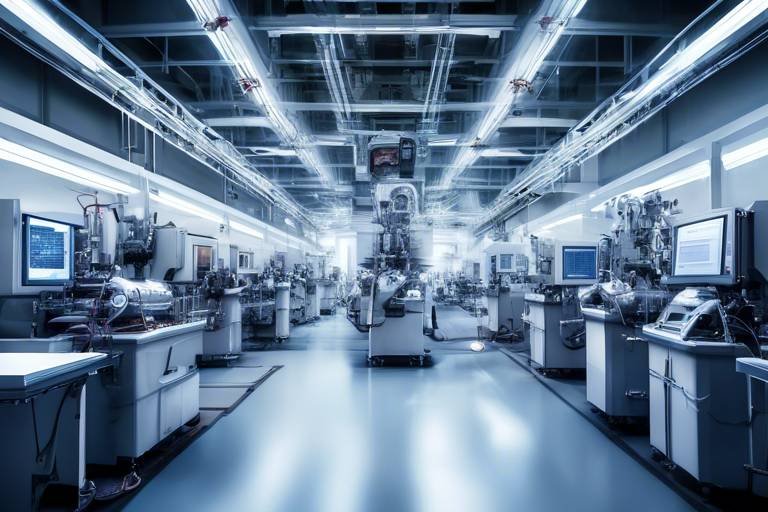How 3D Printing is Transforming Medical Science
3D printing, often dubbed as the next industrial revolution, is reshaping various sectors, and medical science is no exception. Imagine a world where doctors can create patient-specific implants, prosthetics, and even organs tailored to individual needs. This is not science fiction; it's happening right now! The remarkable ability of 3D printing to produce complex, customized structures is revolutionizing how we approach healthcare, making treatments more effective and accessible.
At the heart of this transformation are advancements in 3D printing technologies that have significantly improved precision and efficiency. From biocompatible materials to sophisticated printing techniques, the landscape is evolving rapidly. Surgeons and medical professionals are now equipped with tools that allow them to visualize and manipulate anatomical structures in ways that were once unimaginable. This article delves into the key innovations, applications, and future potential of 3D printing in medical science, highlighting its role in personalized medicine, surgical planning, and bioprinting.
The realm of 3D printing is constantly evolving, with new technologies emerging that enhance its capabilities in medical applications. Recent innovations have led to the development of multi-material printing, which allows for the creation of complex structures using various materials simultaneously. This is particularly beneficial in medical settings where different tissues and materials need to be mimicked to create realistic models.
Moreover, advancements in resolution and speed have made it possible to produce intricate designs more quickly and accurately. For instance, high-resolution printers can create detailed anatomical models that help surgeons plan complex procedures, ensuring that every muscle and bone is represented accurately. The precision of these technologies not only improves outcomes but also reduces the time patients spend in surgery.
One of the most exciting applications of 3D printing is in the field of prosthetics. Traditional prosthetics can be expensive and time-consuming to produce, but 3D printing is changing that narrative. With the ability to create customized, lightweight, and affordable prosthetic solutions, patients are experiencing a significant improvement in their mobility and overall quality of life.
The beauty of 3D printing lies in its ability to create custom-fit prosthetics. Each person's anatomy is unique, and 3D printing allows for a tailored approach that ensures better comfort and functionality. Imagine wearing a prosthetic limb that fits like a glove, designed specifically for your body. This level of customization not only enhances the user experience but also promotes better health outcomes.
3D printing fosters a collaborative approach to design, allowing patients to be actively involved in the creation of their prosthetics. This patient-centric design process empowers individuals, giving them a sense of ownership and satisfaction with their devices. When patients are part of the design journey, they are more likely to embrace their prosthetics, leading to better adaptation and use.
Another significant advantage of 3D printing in prosthetics is cost-effectiveness. By minimizing material waste and reducing production time, 3D printing has the potential to lower the costs associated with prosthetic devices. This makes them more accessible to a wider range of patients, breaking down financial barriers that have traditionally hindered access to quality care.
Surgeons are increasingly turning to 3D-printed models to enhance their surgical planning. These models allow them to visualize complex anatomies and improve precision during operations. Imagine a surgeon holding a 3D-printed replica of a patient's organ, allowing them to practice the procedure before the actual surgery. This not only boosts confidence but also significantly reduces the risk of complications.
Bioprinting is another frontier in medical innovation, enabling the creation of living tissues and organs. This groundbreaking technology holds immense potential for transplantation and regenerative medicine. The ability to print organs on demand could revolutionize the way we approach organ transplants, addressing the critical shortage of donor organs.
Despite its promise, bioprinting faces challenges, particularly in terms of vascularization and tissue integration. Researchers are actively working to overcome these hurdles, striving for successful applications in human medicine. The journey is complex, but the potential rewards are monumental—imagine a future where organ rejection is a thing of the past!
Looking ahead, the future of 3D printing in medical science is incredibly promising. Ongoing research and technological advancements are paving the way for groundbreaking treatments and solutions in healthcare. As we continue to explore the possibilities, we may find ourselves on the brink of a revolution that changes the very fabric of medical science.
- What is 3D printing? 3D printing is a process of creating three-dimensional objects from a digital file, layer by layer.
- How is 3D printing used in medicine? It is used for creating prosthetics, surgical models, and even bioprinted tissues and organs.
- What are the benefits of 3D printing in healthcare? Benefits include customization, cost-effectiveness, and improved patient outcomes.
- Are there any risks associated with 3D printing in medicine? Yes, challenges such as material compatibility and regulatory issues need to be addressed.

Innovations in 3D Printing Technologies
Recent advancements in 3D printing technologies have significantly enhanced precision and efficiency in medical applications, allowing for the creation of complex structures that were previously unimaginable. Imagine a world where doctors can print organs, tissues, and even prosthetics on-demand! This isn't science fiction; it's the reality we're stepping into thanks to the innovations in 3D printing. The technology has evolved from simple plastic models to sophisticated machines capable of printing with biocompatible materials, metals, and living cells.
One of the most significant breakthroughs is the introduction of multi-material printing. This allows for the combination of different materials in a single print job, creating products that can mimic the complex properties of natural tissues. For instance, a prosthetic limb can be printed with a lightweight yet durable outer shell while incorporating softer materials for comfort where it meets the skin. This level of customization is a game-changer in the medical field, as it caters to the unique needs of each patient.
Furthermore, the speed of printing has dramatically improved. Traditional manufacturing methods can take days or even weeks, but with modern 3D printers, we can produce intricate structures in a matter of hours. This rapid prototyping capability means that doctors can quickly adapt to changes in a patient’s condition or even create emergency solutions on the fly. Imagine a surgeon needing a specific tool for an operation; instead of waiting for a manufacturer, they can print it right in the hospital!
Another exciting innovation is the integration of artificial intelligence (AI) into the 3D printing process. AI can analyze patient data and assist in creating highly personalized medical devices or implants. For example, by studying a patient’s anatomy through imaging data, AI can help design a 3D-printed implant that fits perfectly, thereby reducing recovery time and enhancing the overall success of surgical procedures.
Additionally, the development of bioprinting—which involves printing living cells to create tissues—has opened new doors in regenerative medicine. Scientists are now able to print tissues that can be used for drug testing or even for transplantation in the future. This innovative approach could potentially eliminate organ transplant waiting lists and reduce the risk of rejection since the tissues could be printed using a patient's own cells.
In summary, the innovations in 3D printing technologies are not just enhancing the way we create medical devices and prosthetics; they are fundamentally changing the landscape of medical science. With ongoing research and development, the future holds even more promise for personalized medicine, making healthcare more efficient, effective, and accessible for everyone.

Applications in Prosthetics
3D printing is revolutionizing the field of prosthetics, offering a myriad of benefits that traditional manufacturing methods simply cannot match. Imagine a world where individuals can walk with confidence, sporting prosthetic limbs that are not only functional but also tailored specifically to their unique anatomy. This is not just a dream; it's a reality being shaped by innovative 3D printing technologies. The ability to create customized, lightweight, and affordable prosthetic solutions is enhancing mobility and significantly improving the quality of life for many.
One of the most striking advantages of 3D printing in prosthetics is the customization and fit. Traditional prosthetics often come in standard sizes, which can lead to discomfort and inefficiency. However, with 3D printing, prosthetics can be designed to fit the exact measurements of a patient’s limb. This means that every curve and contour is accounted for, providing a more comfortable and functional experience. Imagine wearing a shoe that fits perfectly; that’s the kind of comfort 3D-printed prosthetics can offer.
The ability to create custom-fit prosthetics through 3D printing ensures that each device meets the specific anatomical requirements of the patient. This not only enhances comfort but also improves functionality. For instance, a prosthetic leg designed specifically for an athlete can be optimized for performance, while one designed for everyday use can prioritize comfort and ease of movement. This level of customization is a game changer in the field of prosthetics.
Another exciting aspect of 3D printing in prosthetics is the patient-centric design. Patients are no longer passive recipients of medical devices; instead, they can actively participate in the design process. This not only fosters a sense of ownership but also leads to greater satisfaction with the final product. Imagine being able to choose the color, style, and even the weight of your prosthetic limb! This level of involvement can boost a patient's confidence and encourage them to embrace their new device.
Cost is often a significant barrier when it comes to obtaining prosthetic devices. However, 3D printing is proving to be a cost-effective solution. By reducing material waste and shortening production times, 3D printing can lower the overall costs associated with prosthetics. This means that more patients can access high-quality, personalized prosthetic devices. In fact, studies have shown that 3D-printed prosthetics can be produced at a fraction of the cost of traditional methods, making them a viable option for many who previously could not afford them.
In conclusion, the applications of 3D printing in prosthetics are vast and transformative. From enhanced customization and patient involvement to significant cost savings, the impact is profound. As technology continues to evolve, we can expect even more innovations in this field, paving the way for a future where everyone, regardless of their physical challenges, can lead a fulfilling and active life.
- What types of materials are used in 3D-printed prosthetics?
Common materials include thermoplastics, silicone, and various composites that provide durability and flexibility. - How long does it take to create a 3D-printed prosthetic?
The time varies depending on the complexity of the design, but many prosthetics can be produced within a few days. - Are 3D-printed prosthetics as strong as traditional ones?
Yes, when designed properly, 3D-printed prosthetics can be just as strong and durable as their traditionally manufactured counterparts. - Can 3D printing be used for all types of prosthetics?
While 3D printing is suitable for many types of prosthetics, some complex cases may still require traditional manufacturing methods.

Customization and Fit
The beauty of 3D printing lies in its unparalleled ability to create custom-fit prosthetics that cater specifically to the unique anatomical needs of each patient. Imagine walking into a clinic where instead of generic prosthetic limbs that might not fit quite right, you are presented with a device that feels like it was made just for you. That's the magic of 3D printing! It allows for a level of personalization that traditional manufacturing methods simply cannot match.
When it comes to prosthetics, comfort and functionality are paramount. With 3D printing, healthcare professionals can utilize advanced scanning technology to capture the precise measurements of a patient's limb. This data is then used to design a prosthetic that fits snugly, reducing the risk of discomfort and sores that can arise from ill-fitting devices. The result? Patients experience improved mobility and a greater sense of normalcy in their everyday lives.
Moreover, the design process is incredibly engaging for patients. They can actively participate in creating their prosthetic, choosing colors, patterns, and even features that resonate with their personality. This involvement fosters a sense of ownership and pride, making the prosthetic not just a medical device but a personal statement. It’s like choosing a new outfit that not only looks good but feels good, enhancing the wearer’s confidence.
One of the most significant advantages of 3D printing in prosthetics is cost-effectiveness. Traditional prosthetic manufacturing often involves extensive material waste and lengthy production times. In contrast, 3D printing minimizes waste by using only the necessary materials, and the production process can be completed in a fraction of the time. This efficiency translates to lower costs, making high-quality prosthetics accessible to a broader range of patients.
In summary, the customization and fit capabilities of 3D printing are revolutionizing the prosthetics industry. By providing tailored solutions that enhance comfort, functionality, and affordability, this technology is not just changing lives; it’s transforming the very essence of rehabilitation. As we look to the future, we can expect even more innovations that will continue to push the boundaries of what’s possible in personalized healthcare.
- What is 3D printing in the context of prosthetics?
3D printing in prosthetics refers to the use of additive manufacturing technologies to create custom prosthetic limbs tailored to the unique anatomy of individual patients. - How does 3D printing improve comfort in prosthetics?
By allowing for precise measurements and designs based on a patient's unique anatomy, 3D printing ensures a better fit, reducing discomfort and the risk of sores. - Is 3D printed prosthetics more affordable than traditional ones?
Yes, 3D printing reduces material waste and production time, leading to lower costs, making prosthetics more accessible to a wider audience. - Can patients participate in the design of their prosthetics?
Absolutely! 3D printing encourages patient involvement in the design process, allowing them to choose features that resonate with their personal style.

Patient-Centric Design
When it comes to 3D printing in prosthetics, the term takes on a whole new meaning. Imagine walking into a clinic where the prosthetic limb isn't just a generic model, but a device crafted specifically for you, tailored to fit your unique body and lifestyle. This is the magic of 3D printing! By involving patients in the design process, healthcare professionals can create prosthetics that are not only functional but also resonate with the individual’s personal needs and preferences.
One of the most remarkable aspects of patient-centric design is the opportunity for patients to express their desires and requirements. This collaborative approach ensures that the final product is a true reflection of the user’s identity. For instance, a child might want a prosthetic arm that resembles their favorite superhero, while an adult might prefer a sleek, modern design. This level of customization goes beyond mere aesthetics; it fosters a sense of ownership and pride in the prosthetic device, which can significantly enhance the patient’s mental and emotional well-being.
Furthermore, the technology behind 3D printing allows for rapid prototyping. This means that adjustments can be made quickly and efficiently based on patient feedback. If a patient finds that a certain part of the prosthetic is uncomfortable or doesn't fit quite right, modifications can be made without the lengthy delays associated with traditional manufacturing methods. This responsiveness not only improves comfort but also builds trust between the patient and the healthcare provider.
To illustrate the impact of patient-centric design, consider the following benefits:
- Enhanced Comfort: Custom-fit designs ensure that the prosthetic aligns perfectly with the patient’s anatomy, reducing discomfort and irritation.
- Improved Functionality: By taking into account the patient's daily activities, prosthetics can be designed to enhance mobility and usability.
- Increased Satisfaction: When patients have a say in the design process, they are more likely to feel satisfied with the end result, leading to better adherence and use of the prosthetic.
In conclusion, patient-centric design in 3D printing is not just about creating a prosthetic limb; it’s about crafting a solution that empowers individuals and enhances their quality of life. As this technology continues to evolve, we can expect even more innovative approaches that prioritize the needs and preferences of patients. The future of prosthetics is bright, and it’s all about putting the patient first!
Q1: How does 3D printing improve the customization of prosthetics?
A1: 3D printing allows for precise measurements and designs tailored to the individual’s anatomy, resulting in a prosthetic that fits comfortably and functions effectively.
Q2: Can patients participate in the design process?
A2: Absolutely! The design process can be collaborative, allowing patients to express their preferences, which leads to a more satisfying and personalized prosthetic experience.
Q3: What are the cost benefits of using 3D printing for prosthetics?
A3: 3D printing reduces material waste and production time, which can significantly lower the overall costs of prosthetics, making them more accessible to patients.
Q4: Will 3D printed prosthetics be as durable as traditional ones?
A4: Yes, 3D printed prosthetics are made from advanced materials that can be just as durable, if not more so, than traditional prosthetic devices.

Cost-Effectiveness
When we think about the cost of healthcare, it often feels like a never-ending spiral of expenses, doesn’t it? But here’s where 3D printing steps in like a superhero in scrubs! By dramatically reducing production costs, this technology is not just a game-changer; it's a life-saver for many individuals in need of prosthetics. Traditional manufacturing methods can be both time-consuming and expensive, often leading to high prices for patients. However, with 3D printing, the landscape is shifting. Imagine being able to create a prosthetic limb tailored specifically for you, and at a fraction of the cost!
One of the most significant advantages of 3D printing is its ability to minimize material waste. Traditional methods often involve cutting away excess material from larger blocks, leading to a lot of wasted resources. In contrast, 3D printing uses only the material needed to create the final product, which not only saves money but also contributes to a more sustainable approach in healthcare. It’s like cooking a meal and using every ingredient without throwing anything away!
Moreover, the speed at which 3D-printed prosthetics can be produced is astonishing. What used to take weeks or even months can now be accomplished in days. This rapid turnaround time not only benefits patients who are eager to regain mobility but also reduces labor costs for manufacturers. Think about it: less time spent on production means more patients can be helped in a shorter period. It’s a win-win situation!
Additionally, 3D printing facilitates the creation of customized designs that fit the unique anatomy of each patient. This personalization means that patients are less likely to face discomfort or complications that can arise from ill-fitting devices. When a prosthetic fits well, it not only enhances mobility but also reduces the need for follow-up adjustments, which can be costly. Imagine the relief of knowing that your prosthetic is designed just for you, saving both time and money in the long run!
To summarize the cost-effectiveness of 3D printing in prosthetics, let’s take a look at the following table:
| Aspect | Traditional Manufacturing | 3D Printing |
|---|---|---|
| Production Time | Weeks to Months | Days |
| Material Waste | High | Low |
| Customization | Limited | Extensive |
| Cost | High | Lower |
The implications of these cost savings extend beyond just the individual. As more patients gain access to affordable and effective prosthetics, the overall burden on healthcare systems can be alleviated. This means that hospitals and clinics can allocate resources to other critical areas, improving the quality of care across the board. In essence, 3D printing is not just about making prosthetics; it’s about creating a more efficient and patient-friendly healthcare system.

Innovative Surgical Planning
In the fast-paced world of medicine, 3D printing is proving to be a game-changer, particularly when it comes to surgical planning. Imagine a surgeon preparing for a complex operation; instead of relying solely on traditional imaging techniques, they can now hold a physical model of the patient’s anatomy in their hands. This revolutionary approach allows for enhanced visualization and understanding of the intricate structures involved in surgery. It’s like having a detailed roadmap before embarking on a journey, ensuring that every twist and turn is accounted for.
Surgeons can utilize these 3D-printed models to rehearse procedures, test different approaches, and even tailor their techniques to the specific needs of the patient. This level of preparation not only boosts confidence but also significantly enhances the precision of the operation. For example, a surgeon can practice on a replica of a patient’s tumor, allowing them to plan the best way to remove it while minimizing damage to surrounding tissues.
One of the standout benefits of using 3D printing in surgical planning is the ability to create models from various materials that mimic the properties of human tissues. This means that surgeons can feel the texture and resilience of the tissues they will be working with, which is invaluable for developing a surgical strategy. Additionally, these models can be made in different sizes and scales, allowing for a personalized approach that is tailored to the unique anatomy of each patient.
Furthermore, 3D printing facilitates collaboration among medical teams. When multiple specialists are involved in a patient's care, having a shared model can significantly improve communication. It’s much easier to discuss a strategy when everyone is looking at the same representation of the patient’s anatomy. This collaborative effort can lead to improved outcomes and a more cohesive treatment plan.
To illustrate the impact of 3D printing on surgical planning, consider the following table showcasing various applications:
| Application | Description | Benefits |
|---|---|---|
| Preoperative Planning | Creating models for complex surgeries | Enhanced visualization and strategy development |
| Training | Using models for surgical education | Improved skills and confidence for trainees |
| Patient Communication | Providing models to explain procedures | Better understanding and satisfaction for patients |
As we look to the future, the integration of 3D printing into surgical planning is set to expand even further. With advancements in technology and materials, we can expect even more accurate and functional models that will continue to enhance surgical outcomes. The potential for personalized medicine is truly exciting, and it’s clear that 3D printing is paving the way for a new era in healthcare.
- What is 3D printing in surgical planning? - It involves creating physical models of patient anatomy to help surgeons prepare for complex procedures.
- How does 3D printing improve surgical outcomes? - By allowing surgeons to visualize and practice on accurate models, which enhances precision and confidence.
- Can 3D-printed models be used for training? - Yes, they are excellent tools for surgical education, helping trainees develop their skills in a realistic setting.

Bioprinting and Tissue Engineering
Bioprinting is a groundbreaking technology that merges the principles of 3D printing with the complexities of biological science. Imagine being able to create living tissues and even organs layer by layer, using a printer that operates much like the one on your desk but with a much higher purpose. This incredible innovation is not just a concept; it’s actively reshaping the landscape of medical science and holds the promise of revolutionizing transplantation and regenerative medicine.
The process of bioprinting involves using bioinks—substances made from living cells and biomaterials—to construct tissues that mimic the natural architecture of human organs. This means that instead of relying on donor organs, which can be scarce and often come with complications, we could potentially print organs on demand. Think of it like crafting a bespoke suit, tailored perfectly to fit the unique specifications of each individual.
However, the journey of bioprinting is not without its challenges. One of the most significant hurdles researchers face is vascularization, which is the formation of blood vessels within the printed tissues. Without a proper blood supply, even the most sophisticated tissue structures cannot survive. Additionally, tissue integration poses another challenge, as printed tissues must seamlessly integrate with the body’s existing biological systems to function effectively. Overcoming these obstacles requires a combination of innovative materials, advanced printing techniques, and a deep understanding of human biology.
Despite these challenges, the potential applications of bioprinting are vast. Here are some exciting possibilities:
- Transplantation: Custom organs could be printed for patients, reducing the waiting time and the risk of rejection.
- Drug Testing: Bioprinted tissues can serve as models for testing new drugs, allowing for more accurate predictions of how the human body will respond.
- Tissue Repair: Bioprinting could be used to create patches for damaged tissues, promoting healing and regeneration.
As we look to the future, the prospects of bioprinting and tissue engineering are incredibly promising. Ongoing research and technological advancements are paving the way for breakthroughs that could lead to new treatments and solutions in healthcare. The vision of a future where we can print organs and tissues is tantalizing, and while we may not be there yet, the journey is well underway.
Q: What is bioprinting?
A: Bioprinting is a process that uses 3D printing technology to create living tissues and organs using bioinks made from living cells.
Q: What are the main challenges of bioprinting?
A: The main challenges include ensuring vascularization (the formation of blood vessels) and tissue integration with the body.
Q: How can bioprinting impact organ transplantation?
A: Bioprinting has the potential to create custom organs on demand, reducing the need for donor organs and the associated risks of rejection.
Q: What are the potential applications of bioprinting?
A: Potential applications include organ transplantation, drug testing, and tissue repair.

Challenges in Bioprinting
While bioprinting is a groundbreaking frontier in medical science, it comes with its fair share of challenges that researchers and medical professionals must navigate. One of the most significant hurdles is the issue of vascularization. In simpler terms, for any printed tissue or organ to function effectively, it needs a supply of blood vessels to deliver nutrients and remove waste. Without proper vascularization, even the most sophisticated bioprinted structures can face rapid cell death, rendering them ineffective for transplantation.
Another challenge lies in the integration of bioprinted tissues with the host body. When a bioprinted organ is implanted, it must seamlessly connect with existing tissues and integrate into the body’s biological systems. This integration is critical for the organ to function properly, and achieving it remains a complex task that researchers are still trying to master.
Moreover, the materials used in bioprinting play a crucial role in the success of the printed structures. The bioinks—composed of living cells and other materials—must not only support cell viability but also mimic the natural extracellular matrix that cells thrive in. This requirement adds another layer of complexity to the bioprinting process, as scientists must continuously innovate to develop new materials that can meet these stringent criteria.
In addition to these technical challenges, there are also regulatory hurdles that must be addressed before bioprinted organs can become a standard part of medical practice. Regulatory bodies require extensive testing and validation to ensure that bioprinted tissues are safe and effective for human use. This process can be lengthy and costly, potentially delaying the availability of these revolutionary treatments.
Despite these challenges, the field of bioprinting is making strides, with ongoing research focused on overcoming these obstacles. For instance, scientists are exploring various methods to enhance vascularization, such as incorporating microfluidic channels into bioprinted tissues to promote blood flow. As technology advances, the hope is that many of these challenges will be addressed, paving the way for the successful application of bioprinting in human medicine.
- What is bioprinting?
Bioprinting is a 3D printing technology that uses living cells and biomaterials to create tissues and organs. - What are the main challenges of bioprinting?
The main challenges include vascularization, tissue integration, material selection, and regulatory hurdles. - How can vascularization be improved in bioprinting?
Researchers are exploring methods like microfluidic channels to enhance blood flow in bioprinted tissues. - Is bioprinting safe for human use?
Extensive testing and regulatory approval are required before bioprinted tissues can be used in humans.

Future Prospects
As we look ahead, the future of 3D printing in medical science is nothing short of exhilarating. The rapid pace of technological advancements is opening doors to possibilities that were once confined to the realm of science fiction. Imagine a world where organs can be printed on-demand, tailored to the specific needs of patients, eliminating the agonizing wait for transplants. This isn't just a dream; it's becoming a reality!
One of the most exciting prospects is the development of bio-ink, a substance made from living cells that can be used in the 3D printing process. With this technology, researchers are working towards creating complex tissues that mimic the functionality of real organs. The potential applications are staggering:
- Organ Transplants: Reducing the dependency on donor organs.
- Drug Testing: Creating human tissues for testing new medications.
- Personalized Medicine: Tailoring treatments to individual patient profiles.
Moreover, the integration of artificial intelligence with 3D printing is set to revolutionize the field even further. AI can analyze patient data to optimize the design of prosthetics or implants, ensuring a perfect fit and functionality. This synergy could lead to faster production times and improved outcomes for patients.
Additionally, the potential for remote surgeries is on the horizon. Imagine surgeons being able to operate on patients from thousands of miles away, using 3D-printed models to guide their hands. This could be particularly beneficial in regions where specialized medical expertise is scarce.
Of course, there are hurdles to overcome. Regulatory challenges and ethical considerations regarding bioprinting will require careful navigation. Ensuring the safety and efficacy of these innovations is paramount. However, with ongoing research and collaboration between scientists, engineers, and medical professionals, we are steadily moving toward a future where 3D printing is an integral part of healthcare.
In conclusion, the future of 3D printing in medical science is bright and full of potential. As we continue to innovate and push the boundaries of what's possible, we can expect to see transformative changes that will not only enhance medical treatments but also improve the quality of life for countless individuals around the globe.
To help you understand more about the exciting world of 3D printing in medical science, here are some frequently asked questions:
- What is 3D printing in medical science?
3D printing in medical science refers to the use of additive manufacturing technologies to create medical devices, prosthetics, implants, and even tissues and organs. - How does 3D printing benefit patients?
It allows for customized solutions tailored to individual anatomical needs, improving comfort and functionality while also reducing costs. - What are the challenges of bioprinting?
Challenges include ensuring proper vascularization and tissue integration for successful applications in human medicine. - What is bio-ink?
Bio-ink is a material made from living cells used in 3D printing to create tissues and organs.
Frequently Asked Questions
- What is 3D printing in medical science?
3D printing in medical science refers to the use of additive manufacturing technologies to create medical devices, prosthetics, and even tissues and organs. It allows for the production of complex structures tailored specifically to the needs of individual patients, enhancing precision and personalization in healthcare.
- How is 3D printing transforming prosthetics?
3D printing is revolutionizing prosthetics by enabling the creation of customized, lightweight, and affordable devices. This technology allows for a perfect fit for each patient, improving comfort and functionality, and ultimately enhancing their quality of life.
- Can patients participate in the design of their prosthetics?
Absolutely! One of the most exciting aspects of 3D printing is that it allows patients to be involved in the design process. This collaboration fosters a sense of ownership and satisfaction, ensuring that the final product meets their unique needs and preferences.
- What are the cost benefits of 3D printed prosthetics?
3D printing significantly reduces material waste and production time, leading to lower costs for prosthetics. This makes them more accessible to a broader range of patients, which is a game-changer in the field of medical devices.
- How does 3D printing improve surgical planning?
Surgeons can use 3D-printed models of patients' anatomies to enhance their surgical planning. This technology allows them to visualize complex structures, leading to improved precision and outcomes during operations.
- What is bioprinting?
Bioprinting is a specialized form of 3D printing that focuses on creating living tissues and organs. This innovative approach has the potential to revolutionize transplantation and regenerative medicine, paving the way for groundbreaking treatments.
- What challenges does bioprinting face?
Despite its potential, bioprinting encounters challenges such as vascularization and tissue integration. Researchers are actively working to overcome these obstacles to ensure successful applications in human medicine.
- What does the future hold for 3D printing in medical science?
The future looks bright for 3D printing in medical science! Ongoing research and technological advancements are expected to lead to groundbreaking treatments and solutions, making healthcare more personalized and effective.



















